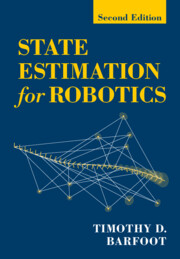Book contents
- Frontmatter
- Contents
- Preface for the First Edition
- Preface for the Second Edition
- Acronyms and Abbreviations
- Notation
- 1 Introduction
- Part I Estimation Machinery
- 2 Primer on Probability Theory
- 3 Linear-Gaussian Estimation
- 4 Nonlinear Non-Gaussian Estimation
- 5 Handling Nonidealities in Estimation
- 6 Variational Inference
- Part II Three-Dimensional Machinery
- Part III Applications
- Part IV Appendices
- References
- Index
3 - Linear-Gaussian Estimation
from Part I - Estimation Machinery
Published online by Cambridge University Press: 11 January 2024
- Frontmatter
- Contents
- Preface for the First Edition
- Preface for the Second Edition
- Acronyms and Abbreviations
- Notation
- 1 Introduction
- Part I Estimation Machinery
- 2 Primer on Probability Theory
- 3 Linear-Gaussian Estimation
- 4 Nonlinear Non-Gaussian Estimation
- 5 Handling Nonidealities in Estimation
- 6 Variational Inference
- Part II Three-Dimensional Machinery
- Part III Applications
- Part IV Appendices
- References
- Index
Summary
We begin our journey into state estimation by considering systems that can be modelled using linear equations corrupted by Gaussian noise. While these linear-Gaussian systems are severe approximations of real robots, the mathematics are very amenable to straightforward analysis. We discuss the difference between Bayesian estimation and maximum a posteriori estimation in the context of batch trajectory estimation; these two approaches are effectively the same for linear systems, but this contrast is crucial to understanding the results for nonlinear systems later on. After introducing batch trajectory estimation, we show how the structure of the problem gives rise to sparsity in our equations that can be exploited to provide a very efficient solution. Indeed, the famous Rauch-Tung-Striebel smoother (whose forward pass is the Kalman filter) is equivalent to solving the batch trajectory problem. Several other avenues to the Kalman filter are also explored. Although much of the book focusses on discrete-time motion models for robots, we show how to begin with continuous-time models as well; in particular, we make the connection that batch continuous-time trajectory is an example of Gaussian process regression, a popular tool from machine learning.
- Type
- Chapter
- Information
- State Estimation for RoboticsSecond Edition, pp. 40 - 96Publisher: Cambridge University PressPrint publication year: 2024



